Walking saves the day
As I’ve written on Zozhnik before, I’ve lost 50 kilos since last February. Mostly thanks to a proper diet, which was supplemented by a daily brisk walk.
At first I chose long walking as my main exercise quite impulsively, and was very surprised by its effectiveness. It has now become the basis of my aerobic exercise programme, which also includes slow running, ellipticals, exercise bikes and musculoskeletal exercises with my own weight.

It took me about 5,500,000 steps to lose 50kg.
When the extra pounds stopped threatening my life, I decided to make healthy living my main hobby in order to prevent a relapse. And I began to systematically study issues relevant to health promotion. A few days ago, I completed an INWA (International Nordic Walking Federation) instructor course and I would like to share what I learned from it.
Let me be clear: I’ve been losing weight by brisk walking without sticks, and I’ve been engaging my back and shoulder girdle by first actively working the elliptical handles, then doing push-ups and pull-ups. Before the course, I walked 50 kilometres with poles, just to get used to them. So at the start of the course I was not an avid fan of Nordic walking, but rather an interested explorer.
What’s wrong with Nordic walking?
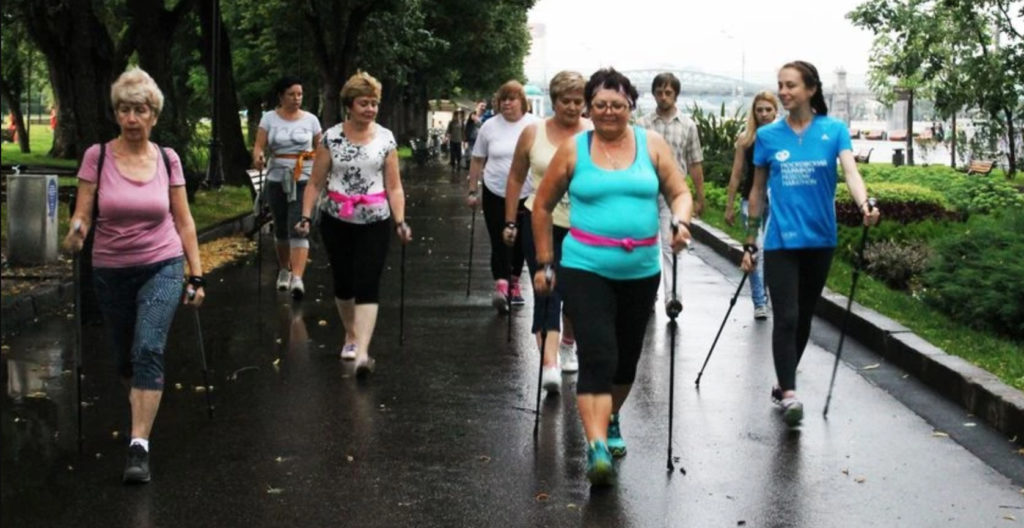
I’ll start by listing the disadvantages of such training.
1. Low prestige
“Popularly, the image of Nordic walking as a ‘retirement occupation’ is firmly entrenched. It was soon enough to post a FB photo, in which I’m briskly striding with the sticks on the embankment of the Moscow River, I immediately got a comment from a well-wisher: “Somehow you quickly turned 65.
Nordic walking attracts people with poor health, because it can be an effective rehabilitation practice. But that, of course, is its virtue, not its disadvantage. Photo from nordic-health.ru
It gets funnier. I was coming back from training one evening. I stand at a traffic light and lean on my cane. An elderly, drunk homeless man comes creeping towards me on crutches. I prepared myself for him to ask for money.
But instead, the bum started asking me questions:
– “You’re young, aren’t you?
I nodded.
– And you walk with sticks?!
I nodded again.
– WHY?!!!
– Life made me do it, I honestly admitted.
– Wow! – The homeless man was surprised, goggling his eyes, and walked away from me, shaking his head. He even forgot to ask for money.
I confess, at that moment I felt embarrassed about my appearance, and it was unpleasant. In general, when walking with the sticks, I sometimes had to catch mocking or puzzled looks from passersby.
I should say at once: now, after I learned Nordic walking technique, I completely got rid of shyness and disdain towards these poles. Now they seem to me as useful and cool fitness equipment as TRX loops. And I rather associate electric bicycles and electric scooters, which are fashionable among young people, with disability.
2. The poles are uncomfortable
Still, Nordic walking poles cannot be called the most comfortable equipment for urban exercise. The poles are two sticks, each a little over a metre long. They can’t be hidden in a pocket and folded up into a bag. You have to carry them in a pouch on your back when not training, or lean them on when you want to stop for a coffee, for example, during training.
A separate problem is the handstrap: a special half-glove that attaches the stick to your hand. It is literally tying the stick to your hand, so you can’t free it quickly if you want to answer the phone, for example. You can hold the phone in your hand, but there is a one metre long pole dangling under your wrist. Not very comfortable.

The photo in the Wikipedia article on the strap shows a model that snaps back. But not all poles have this feature. Source: wikipedia.org
There are some poles which can be brushed from the handle with the push of a button. But this is an option for above average-priced poles. Similarly, folding poles are also available – not telescopic poles, but folding ones, which are approximately 40 cm long when unfolded. After the training they can be stored in a rucksack, but the cost of such poles is rather high, and from what I understood any joint on the folded poles is a place of potential deformation. So, they are not really suitable for constant intensive training.
3. The poles are dangerous.
Every Nordic walking stick ends in a sharp steel tip. If you are not careful, it can injure someone walking or standing nearby.
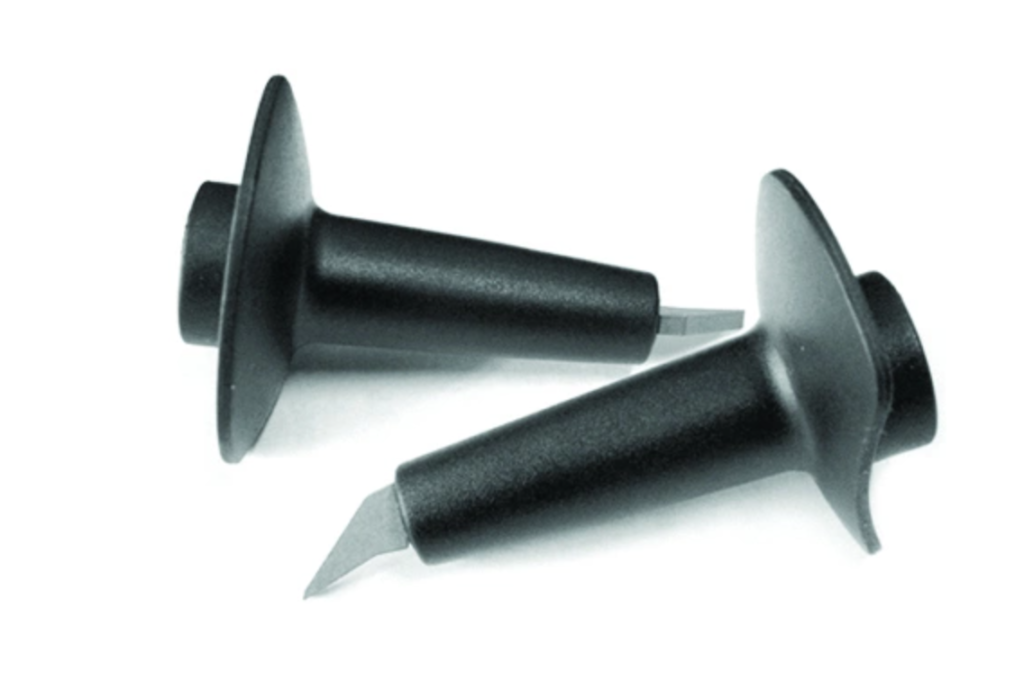
From the outside the Nordic Walking poles look very threatening. Source: Ozon.ru
In a crowd the probability of such an accident increases rapidly: knocked out at you suddenly a cyclist or a mad scooter, who hundreds of runners on the streets of Moscow, you bounced or sharply turned around and immediately hit the “tooth” stick to someone who was walking nearby.
If you hold the stick in your hand at waist level, you could puncture someone in the neighbourhood in the stomach. If you put the tip of the stick upwards, you are in danger of stabbing someone in the eye. In general, a stick is a sharp stabbing object and one must not forget about caution even for a moment, if one has it in his hands.
4. Sticks are annoying.
Walking on the ground with Nordic walking poles is a pure pleasure. But that all changes when you get out on the pavement. On a hard surface they start clattering like the heels of women’s shoes. And that’s if you know how to get them off the ground properly and quickly. Otherwise, they start dragging behind you, making a nasty scratching sound on the stone.
It’s not too pleasant to listen to that throughout your walk.
Of course, for walking on asphalt the sticks have special rubber tips – “boots”. But even they are not a panacea: first, it’s harder to achieve anatomically correct walking technique and pros dislike them, and second, a sharp steel prong during a long walk leads to rubber bands piercing. And sticks start clattering again.
5. You have to know how to use the poles.
It may seem a very simple thought, but for some reason it is not obvious to many people: walking poles should be taught to be used like any other piece of fitness equipment. Without skill, walking poles do not make walking easier, but rather harder and more dangerous.
A stick can be tripped over if you put it in front of your foot unsuccessfully. “Throwing a walking stick behind your back can dislocate your wrist or even break your wrist. If you squeeze the handles too hard your blood pressure rises considerably, which is not good for people of a certain age or for those who take long trainings.
All in all, Nordic walking is never a “get up, walk and do it” story.
Nordic Walking – good news
Now I will tell you why, with all the aforementioned disadvantages I plan to continue Nordic walking and even consider it a very necessary invention.
Let me specify right away: I learned this information not only from courses provided by INWA instructor (first of all, I found them helpful with their excellent practical exercises), but also by studying scientific material on my own.
1. Nordic walking is first of all walking, and then Nordic walking
All explanations of the benefits of Nordic walking are based on the theory of aerobic exercise, which is based on the discoveries of Nobel Prize winner Archibald Hill and was extensively researched and developed by American physician Kenneth Cooper.
This theory states that the human body gets healthier and stronger if it is subjected regularly (preferably daily) to sufficiently long (from 30 minutes) exercise with a pulse in the aerobic zone (75-80% of maximum heart rate). At the same time, it is desirable that such cyclic (repetitive) loads involve 60% or more of the muscles of the whole body. I.e. isolating exercises on machines are not suitable for this.
Kenneth Cooper began developing his training system as a US army doctor. It was used in the training of pilots and astronauts. Source: cooperaerobics.files.wordpress.com.
What can aerobic exercise be? Kenneth Cooper has compiled a list of the five main aerobic exercises in descending order of energy expenditure: skiing, swimming, jogging, cycling and walking.
So when Nordic walking coaches talk about the benefits of their exercise – strengthening the heart, relieving the nervous system, improving breathing, normalising metabolism – they list the positive effects common to all aerobic activity.
2. The poles unload your knees and engage your upper body
So why do we need poles if walking works well on its own?
It’s a reasonable question, and I have two simple answers and a complicated one.
The first simple answer is that, according to Kenneth Cooper’s research, cross-country skiing is the most energy-intensive physical activity. Walking is at least one and a half times less. This is not least because skiing involves the active participation of hands and sticks.
Nordic walking is built on a similar principle, and the work of the hands increases the body’s energy expenditure, bringing it closer to the effectiveness of skiing.
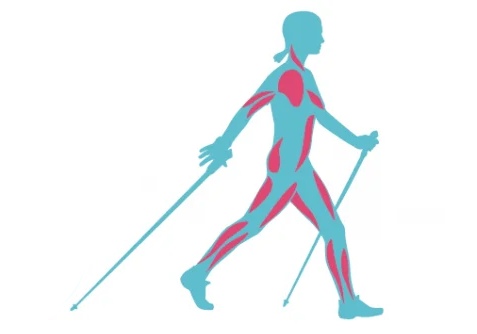
This picture shows you approximately which muscles are involved in Nordic walking.
Secondly, the support of the poles while walking takes the load off your knees, which is very important for people with poor training or who are active e.g. joggers.
When running, there is always a flight phase, when the runner’s legs hover in the air, after which the impact on the knee on landing is equal to 2.5 body weight (this load can be reduced by proper technique and cushioning of trained leg muscles, but the limit value is about this). In a normal walking cycle at least one foot is always in contact with the ground and the load on the knee during a step is 1.4 body weight.
Nordic walking alternates between four and two weight-bearing points (one or two poles touch the ground in addition to the feet). And the load on knees is even less than in walking.
I felt this effect when I discovered that running training twice a day put too much strain on my legs. And when I alternate between running and Nordic walking I am able to train my endurance by giving my knees a rest after running.
3. between proper walking and proper running there are many similarities
Nordic walking and running are based on the same movement: an incline with an offset centre of gravity. When your body with a straight back is so bowed that you have to put one foot in front of the other to avoid falling down. This moment of loss of balance and involuntary steps forward to prevent a fall is the starting point of walking or running. And this feeling of ‘controlled falling’ should be maintained throughout the entire movement.
Control of posture, breathing, tension of abs and relaxation of neck and shoulder girdle muscles are identical in both running and walking.
Nordic walking can be used not only as an independent aerobic exercise, but also as a practice that prepares the body for running or alternates with it.
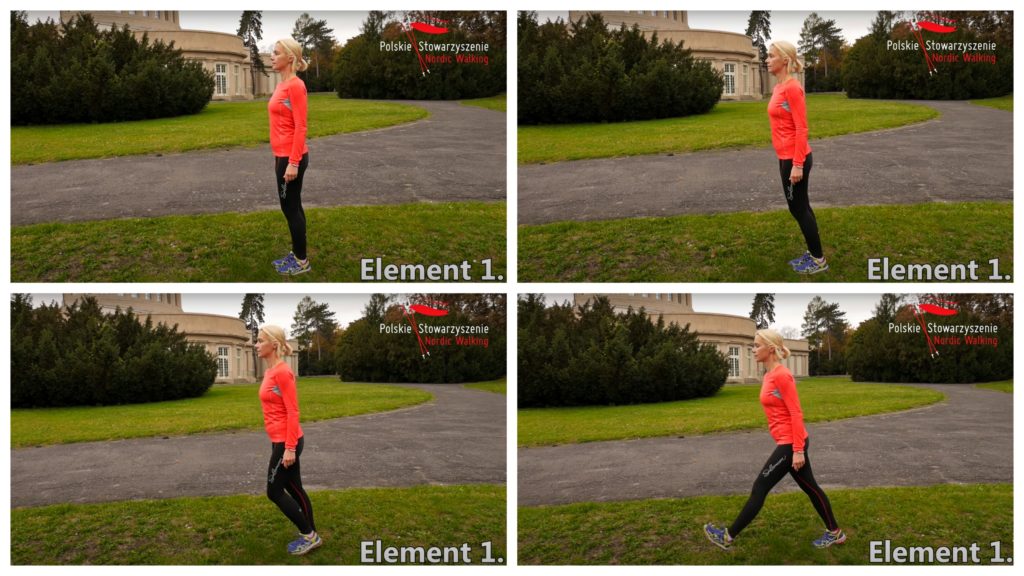
4. Nordic walking doesn’t start with the poles, but with the posture
INWA instructor courses teach that Nordic walking consists of three types of skills: correct posture, correct technique and correct use of sticks. And they have to be taught in this sequence.
The stage of learning posture and learning to walk with it can last up to three months, before a person picks up the sticks and begins to combine them with a regular walking pattern.
Here one can think of the English researcher and trainer James Earls, author of Born to Walk.
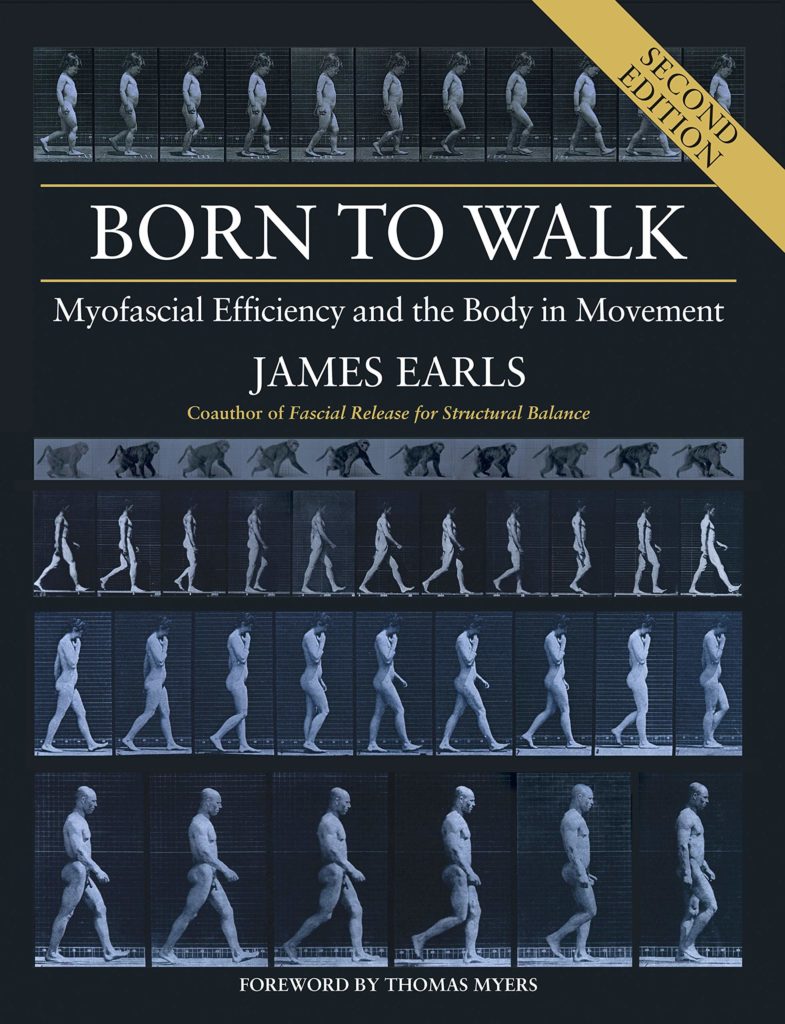
James Earls’ book has not yet been translated into Russian. Our readers are only familiar with it as the co-author of the voluminous Fascial Release for Structural Balance manual.
Earls argues that the experience of walking is central and defining to each individual’s well-being and life, and that its emergence is central to human history. And if you look closely at the structure of our body, you will find that evolution has designed it for two kinds of movement: breathing and stepping. Both of these practices are realised in walking.
That is why it is important to learn not only to move the body in space with legs (“to carry a bag of bones” as they say in INWA), but to master the skill of upright walking, which begins with the correct position of the spine in space, to which is then added a verified movement of the legs, arm position, breathing, head direction…
5. The poles are the ideal warm-up and stretching equipment.
Nordic Walking poles are a unique piece of fitness equipment, whose function during walking has nothing in common with crutches.
They are unique in the sense that they cannot be replaced by ski poles, trekking poles or homemade poles. It’s as ridiculous as trying to play badminton with a tennis racket or vice versa. Nordic walking poles have their own handle design and unique length, unlike other sports poles.
Even the lanyard is designed to suit Nordic walking. It does not only “bind” the stick to your hand, but transfers the load to the stick from your hand when you open it and slide it behind your back. It’s like a bicycle chain from foot to wheel.
The point of Nordic walking is to move in the biomechanics of your natural step with the power of the impulse of the movement on the stick, to which you do not dump your whole body, but push off the ground with it when it is already at your back.
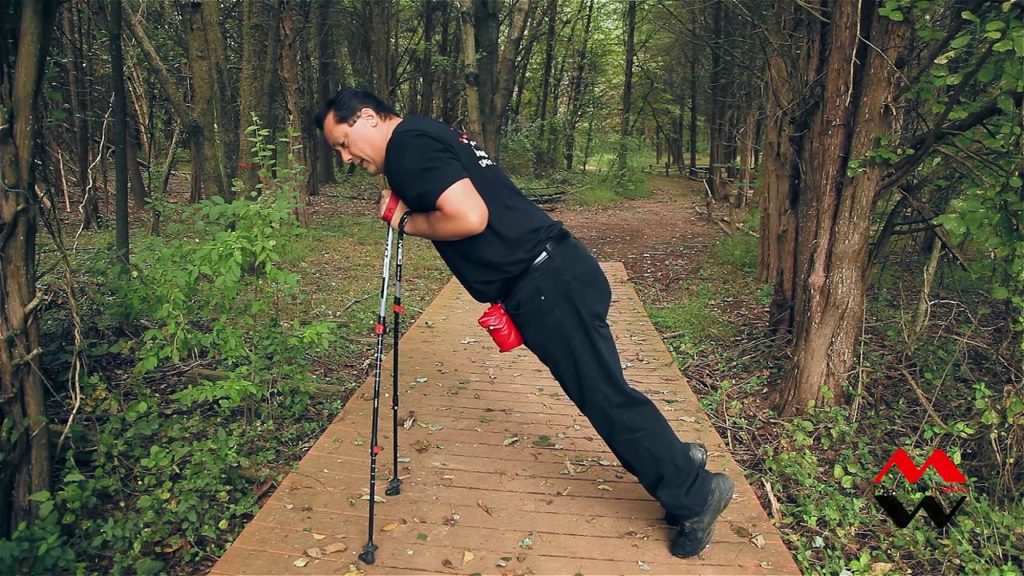
Those who are enthusiastic about walking with poles manage to work out all muscle groups with them. Source: maximumwin.com
I’ve read on the net critical claims that the emergence of Nordic walking was a marketing scam by managers of EXEL (a major manufacturer of ski poles). Allegedly EXEL sponsored research proving the benefits of Nordic walking just to expand the market for its products. (INWA, by the way, make no secret of EXEL’s help and the significance of their role in the emergence of Nordic walking). But I think the worldwide popularity of this invention can hardly be explained by self-interest of marketers alone.
Above I have already mentioned that Nordic walking poles should have a certain length. Now it should be clarified that this length is determined by the body proportions of the person who will use them.
Different sources give different ratios of these proportions.
The most common statement is that the hand of the person standing and holding the Nordic walking stick in front of him/her should form a 90 degree angle at the elbow.
The INWA course teaches that this is slightly outdated information and the stick should be noticeably lower: such that the thumb of the person standing and gripping its handle is at navel level (the elbow will then be bent in an angle of more than 90 degrees).
There is a theory that people with varying degrees of fitness need different lengths of poles:
- For beginners, this would be the value of their height multiplied by a factor of 0.6;
- For people who are physically active at the start, height X 0.66;
- For those who have spent at least a month in the Nordic walking program, height X 0.68;
- For advanced walkers, for whom the functional effect of the training is important – height X 0.7.
In any case, we always base our training on the height of a person and their body proportions (e.g. arm length). This correlation seems very important to me. Thanks to this, the size of the poles appears to be built into the anatomy of the human body and the biomechanics of walking.
I calculated that if the Vitruvian man in Leonardo da Vinci’s drawing had taken a Nordic walking stick long enough to reach from the ground to his navel, and raised it above his head, his arms would have been inscribed in a circle exactly opposite his widely-spread legs. So that the man’s figure would be like an hourglass.
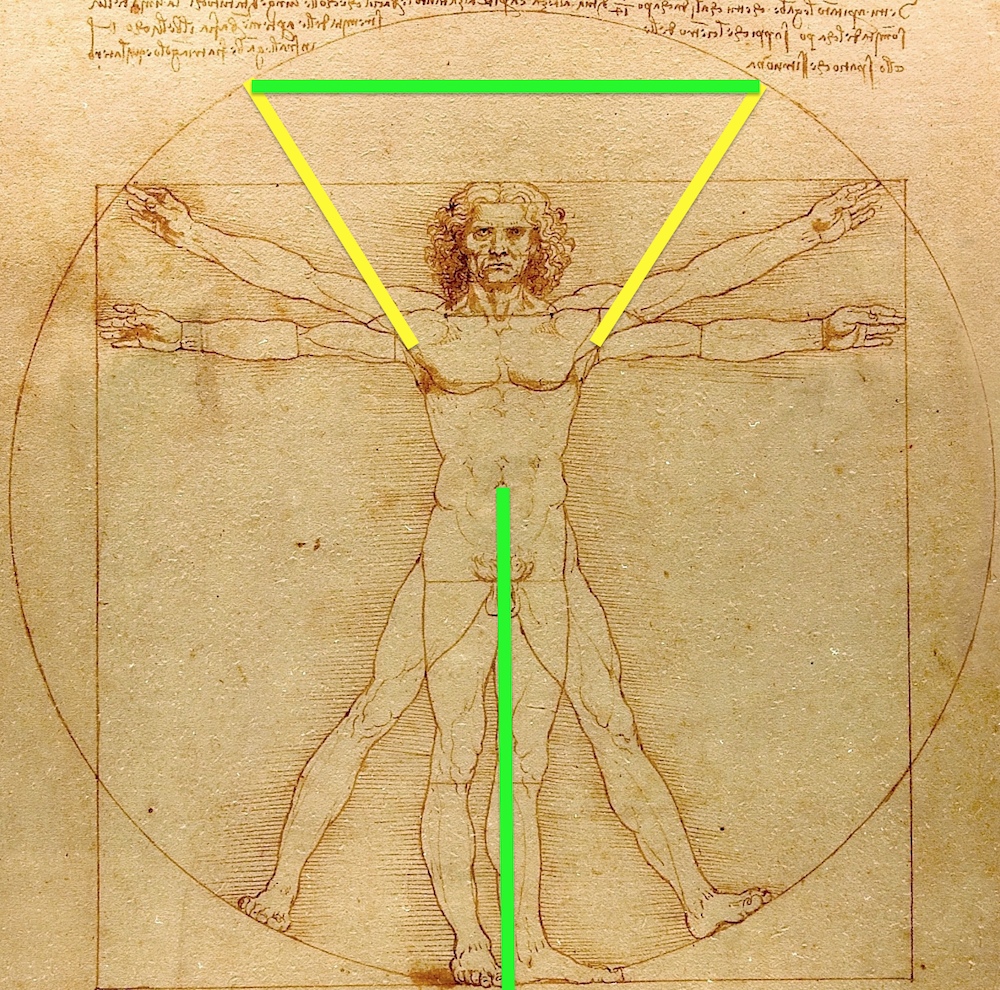
A Nordic walking stick would ideally supplement proportions of Vitruvian man’s body and then his pose would turn into a workout or a stretching.
The comfort of this size ratio can be felt if you start using Nordic Walking poles for warming up and stretching. An arm with a properly sized stick becomes an angled ruler that fits your body proportions perfectly. Thanks to this, the body easily “adjusts” to this “ruler”, engaging different muscles in turn.
For me the Nordic Walking poles have a similar effect to stretching and functional training with TRX bands. Only the poles were more comfortable and fitted better into my body geometry.
What’s the pleasure of walking with poles? (And there it is).
Much has been said above about the appropriateness of walking with poles. But still, most people train not just for the benefits, but also for the enjoyment.
Is there any particular pleasure in walking with poles? I think so. It’s the pleasure of walking, reinforced in a special way by the sticks.
Let me be clear right away: walking is an individual activity for me. I don’t like group walks: talking together, having to adjust to the pace of the company, random stops.
Walking, for me, is a semi-meditative practice, best done alone.
When I walk, breathing, pace and depth of steps can interact in such a harmonious way that the illusion of flight-like lightness, of absolute freedom and creative peace at the same time arises. Walking with poles amplifies this sensation.
The poles don’t just connect the shoulder girdle to the dynamics of the stride. They turn you into the likeness of some kind of quadrupedal animal or even a giant insect (Kafka, hello!). Once your arms and sticks get used to moving in sync with your legs, your body starts to feel completely new: as if it’s active in its entirety and at the same time in a state of perfect balance and rest. Something similar happens when you go for a long, steady swim. But then we are in a water element alien to us, while walking manages to float while staying on the shore.
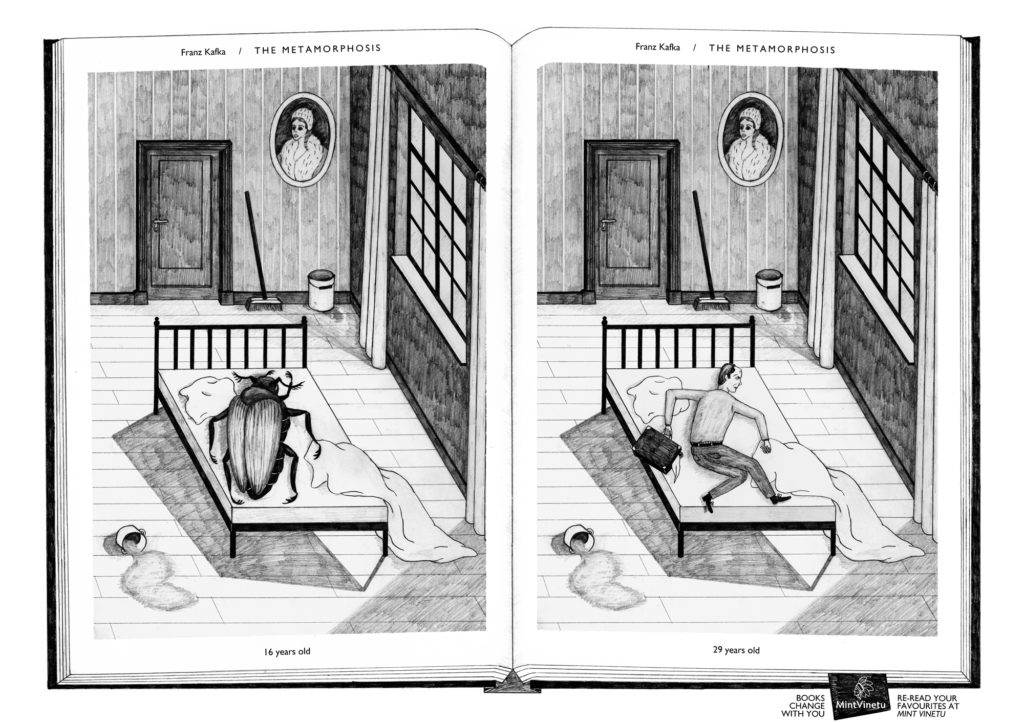
In Franz Kafka’s story “The Transformation”, the hero wakes up to find that he has become a beetle. And this event shows him how infinitely cruel the world around him is. Nordic walking, on the other hand, allows you to feel like an insect and become stronger and freer because of it. Source: newisnew.lt
It’s a very interesting feeling that engages seemingly familiar muscles in a new way when walking.

